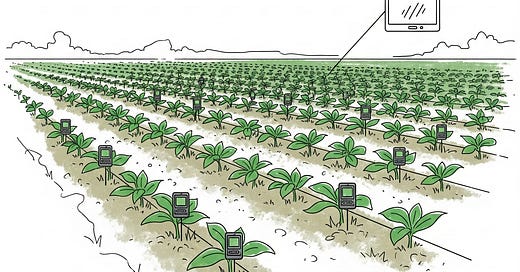Implementing Sensor-Based Irrigation: A Step-by-Step Guide
End the Watering Guesswork: Use Data for Optimal Yields
Water is one of our most important resources on the farm. Getting it just right can be a challenge.
Too little water means stressed plants, while too much not only wastes water but can also harm your crops.
Sensor-based irrigation is a smart solution that takes the guesswork out of watering.
What is Sensor-Based Irrigation?
Sensor-based irrigation uses special devices called sensors placed in the soil or on plants.
These sensors measure important things like soil moisture, soil temperature, or even plant water stress.
The data collected helps you decide exactly when and how much water your crops truly need.
Benefits of Sensor-Based Irrigation:
Optimized Water Use: You water only when necessary and in the right amount, saving water.
Improved Plant Health: Plants consistently receive the ideal amount of water, promoting their growth and vitality.
Higher Yields: Healthier plants often lead to better and more consistent crop yields.
Reduced Labor: Automated systems can control watering based on sensor data, reducing manual effort.
Environmental Protection: Less water waste means a reduced environmental impact.
Lower Operating Costs: Saving water and energy can decrease your overall expenses.
Getting Started with Implementation:
Assess Your Needs: Consider the crops you grow, your soil types, and any specific problems you want to solve (e.g., water scarcity).
Choose the Right Sensors: Different types of sensors are available. Research which ones best suit your crops and budget. Soil moisture sensors are a great starting point.
Plan Sensor Placement: Think about where you will place the sensors in your fields. This depends on field size and soil type variations.
Source System Components: This includes the sensors, a data logger or gateway (to collect data), software for analysis, and potentially an automated irrigation system.
Installation: Place the sensors in the selected locations according to the manufacturer's instructions. Ensure they are calibrated correctly.
Data Collection and Analysis: Begin collecting data. The software will help you identify patterns and make informed irrigation decisions.
Adjustment and Automation: Start manually adjusting your watering based on the data. Over time, you may be able to automate your system.
Tips for Success:
Start small, perhaps with a section of your farm, before expanding the system to your entire operation.
Learn how to interpret the data. Many systems offer user-friendly dashboards.
Combine sensor data with weather forecasts for even more precise decisions.
Maintenance is key. Regularly check sensors and equipment.
Conclusion: The Future of Farming is Data-Driven
At Farmer's Chat, we firmly believe that the future of agriculture lies in harmonizing with nature, supported by innovative technology. Implementing sensor-based irrigation is a bold step in this direction. It empowers farmers to manage water with unprecedented precision, leading to healthier crops, higher yields, and a reduced environmental footprint. As a non-profit initiative, we are dedicated to equipping farmers—the true backbone of our civilization—with the knowledge and tools they need to enhance their practices and protect the planet.
Join us on this journey towards a more sustainable agricultural world! Explore our learning resources for more detailed guides and videos. Connect with fellow farmers on our social media platforms to share experiences and insights. Your engagement helps us continue our vital work for the betterment of agriculture and the planet.
#SensorIrrigation #SmartFarming #WaterEfficiency #PrecisionAgriculture #SustainableFarming #FarmTech #SoilMoisture #CropOptimization #EnvironmentalProtection #FarmInnovation #FarmersChat #Farmers #Chat #VishalRajput #Agriculture




